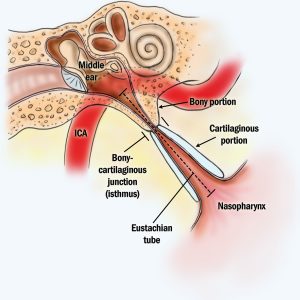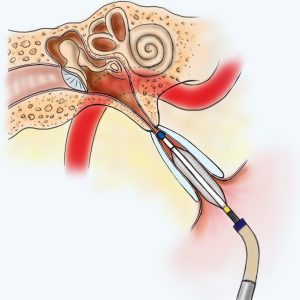Eustachian Tube Dysfunction
What is the Eustachian tube?
The Eustachian tube is a cartilaginous and bony tube providing a connection between the back of the nose (nasopharynx) and the middle ear. At rest, the Eustachian tube is closed, but it opens when you swallow, yawn or sneeze. It can also be opened forcefully by raising pressure in your nasopharynx by blowing your nose and “popping” your ears. When the Eustachian tube opens it allows the equalising of pressure between the external environment and the middle ear by allowing a small amount of air to pass through.
The Eustachian tube connects the middle ear to the nasopharynx
What are the symptoms of Eustachian tube dysfunction?
When the Eustachian tube does not work very well, a number of different symptoms can occur. These include:
- Pain
- Feeling of fullness in the ear
- Ringing in the ears (tinnitus)
- Difficulty hearing
- Dizziness or balance problems
Eustachian tube dysfunction can lead to pain in the ears
What causes Eustachian tube dysfunction?
The main causes of Eustachian tube dysfunction are conditions that lead to swelling in the nose and nasopharynx. These include upper respiratory tract infections, allergy, pollution, and smoking. Other triggers include extreme pressure changes that occur when flying or SCUBA diving, and temporomandibular joint (TMJ) disorders.
How is Eustachian tube dysfunction treated?
Firstly, it is important to see an ENT doctor to exclude other common causes which often produce similar symptoms e.g. impacted ear wax, outer or middle ear infection, sudden sensorineural hearing loss, or ear drum perforation.
Once these other causes have been excluded, the ENT specialist will usually try medication to reduce the swelling which is the causing the blockage of the Eustachian tube. These include nasal decongestants (e.g. Afrin, Iliadin), topical nasal steroid sprays (e.g. Avamys, Nasonex) and antihistamines with decongestants (e.g. Telfast-D, Zyrtec-D).
If the medication doesn’t work, then the patient can consider a procedure in order to relive the symptoms. A small cut in the ear drum can be done under local anaesthetic (myringotomy). If this helps, then a small tube (grommet) can be inserted to keep the hole open. This has several disadvantages, however. In Singapore (because of the humidity), the risk of an ear infection is high – this is more likely if the patient swims regularly. It also cannot be used if the patient is a SCUBA diver.
A promising new treatment – first described in 2011 and only available in Singapore in the last 6 years – is to use a high-pressure balloon to widen the cartilaginous Eustachian tube. Known as Balloon Dilation of the Eustachian tube or Balloon Eustachian Tuboplasty, this simple procedure restores normal tube function and can reduce or resolve the patient’s symptoms. It is usually performed under a short general anaesthetic in day surgery; however, it is increasingly being offered under local anaesthetic. During the operation, a probe is inserted into the affected Eustachian tube and a special balloon is inflated to a set diameter at high pressure (12 atm). You can see a video of the procedure here. Complications from the procedure are rare and the recovery is very quick.
Balloon dilation of the Eustachian tube is a promising new treatment
To find out if you’re a suitable candidate for Balloon Eustachian tube Dilation, please contact The ENT Clinic at +65 6710 7522 to book an appointment!
For more information on ENT Balloon, visit www.easmed.com/ent-balloon/ or drop us a note via customer@easmed.com .
5 minute read
Contributed by Dr Chris Hobbs, The ENT Clinic
Dr. Chris Hobbs
BSc (Hons) MBBS, MRCS, DLO, MD, FRCS(ORL-HNS), FAMS (ORL)
Senior Consultant ENT Head, Neck & Thyroid Surgeon
Mount Elizabeth Novena Hospital
38 Irrawaddy Road | #07-46/47
Singapore, 329563
Ph: +65 6710 7522
Gleneagles Hospital (Annexe Block)
6A Napier Road | #03-41/42
Singapore, 258500
Contact: +65 6251 6332



